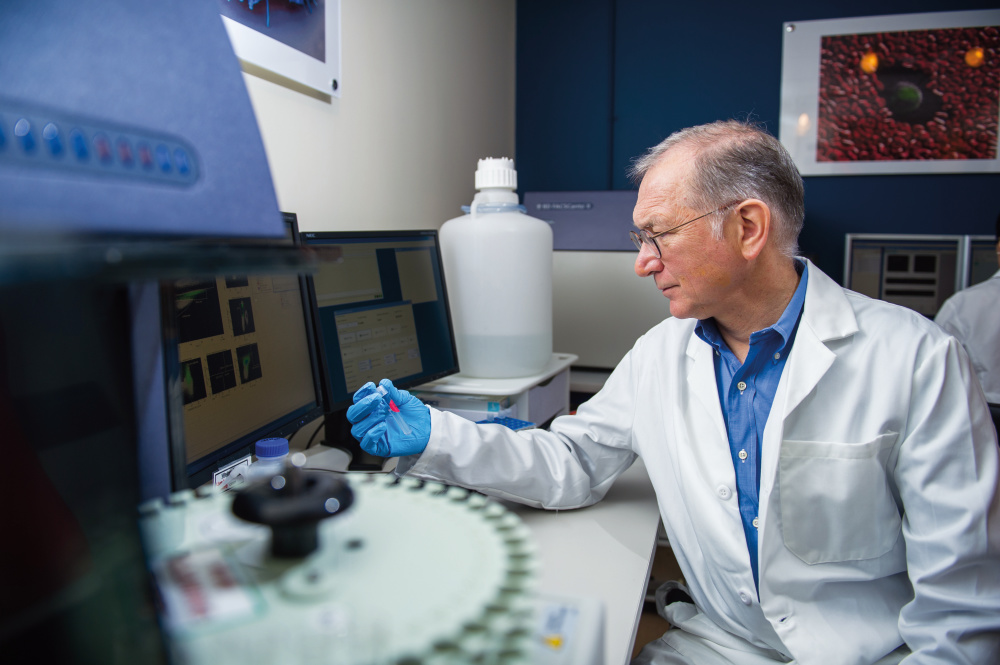What are PD-1 and PD-L1?
PD-L1 is a protein on the surface of some cancer cells that interacts with the PD-1 protein on T cells of the immune system to thwart an immune attack on the cancer. It’s one of the tools that cancer cells use to escape an attack by the immune system and continue their rampant growth and proliferation.
What are PD-1 and PD-L1 inhibitors (also known as checkpoint inhibitors)?
Immunotherapy harnesses the power of the immune system — the body’s defender against infection and disease — to fight cancer. Some of the most effective immunotherapy agents for cancer are drugs known as checkpoint inhibitors, which, by blocking PD-1, PD-L1 and related proteins, give the immune system a go-ahead to attack tumor cells.
Dana-Farber scientist Gordon Freeman, PhD, and his colleagues played a major role in the development of some of these inhibitors. In the early 2000s, they discovered that many types of cancer cells carry PD-L1 on their surface as a way to hide from the immune system. That led pharmaceutical companies to develop drugs targeting PD-L1 and related proteins.
“This is a really different strategy,” Freeman says. “Don’t poison the cancer cell: Let the immune system directly kill it.”

Which cancers can be treated with PD-1 or PD-L1 inhibitors?
Multiple PD-1 and PD-L1 inhibitors have been approved by the U.S. Food and Drug Administration, including:
PD-1 inhibitors
- Nivolumab – used to treat certain types of melanoma, advanced lung cancer, advanced kidney cancer, Hodgkin lymphoma, head and neck squamous cell cancer, advanced bladder cancer, advanced liver cancer, advanced esophageal squamous cell cancer, and colorectal cancer.
- Pembrolizumab – used to treat non-small cell lung cancer, melanoma, bladder cancer, Hodgkin lymphoma, and certain other cancers.
- Cemiplimab – used to treat a type of skin cancer called cutaneous squamous cell carcinoma.
PD-L1 inhibitors
- Atezolizumab – used to treat bladder cancer, non-small cell lung cancer, breast cancer, and small cell lung cancer.
- Avelumab – used to treat Merkel cell carcinoma, bladder cancer, and kidney cancer.
- Durvalumab – used to treat bladder cancer and non-small cell lung cancer.
In many cases, these drugs are used after traditional treatments have stopped working, but they’re increasingly used as front-line therapies as well.
What is the future of PD-L1 inhibitors?
A major area of focus for researchers involves combining PD-1 and PD-L1 inhibitors with other types of treatment, including radiation therapy, targeted agents, cancer vaccines, and some chemotherapy agents.
PD-1/PD-L1 inhibitors, which are made from natural human antibodies, often work better in some types of cancers than others. Researchers are working to understand the reasons for these disparities and to increase the range of cancer types that are susceptible to the drugs.
There are currently about 3,000 clinical trials of PD-L1 inhibitors and PD-1 inhibitors alone or in combination with other agents, across a wide range of cancer types.

This is a great article and hits on many of the future therapeutic avanues for drugs targeting immune checkpoints like PD1. I am working to develop and license the best antibodies to study these pathways and am focused on IHC staining since that seems to be the preferred approach for cancer researchers. Unfortunately these are designed to work in fixed tissues and won’t have therapeutic potential like ipilimumab, the CTLA-4 blocker mentioned, but I saw this as a chance to fit into PD1 immune checkpoint research somewhere. We’ve got some cool staining images at enquirebio.com/programmed-cell-death-protein in several different tumor types that show how widespread expression of PD1 is in a variety of cancers which makes it all the more exciting as an anti-cancer (broad) strategy. Good luck to all the researchers out there chasing this pathway! I think some exciting treatments are bound to emerge soon from this field!